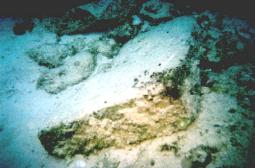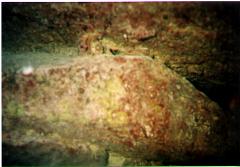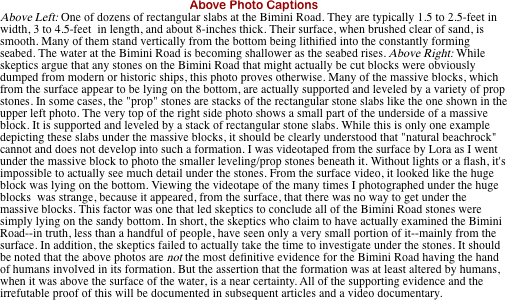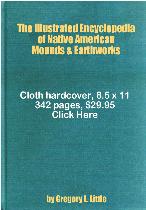Preliminary Report on May 2005 Bimini-Andros Expeditions: Uncovering the Great Bimini Hoax and Pseudoscience Perpetrated by Skeptics by Dr. Greg Little | ||
 | ||||
 | ||||
 | ||
Summary of Findings From May 3 to May 11, a joint team comprised of the ARE's Search For Atlantis Project and The Atlantis Organization performed detailed underwater investigations at both Bimini and Andros. Drs. Greg and Lora Little, archaeologist Bill Donato of The Atlantis Organization, and the ARE's Doris Van Auken were accompanied by Eslie and Krista Brown, who operate KnB EZ Dive at Bimini. Hundreds of photos were taken during the trip, including several spectacular underwater shots of artifacts and stone formations previously unseen or ignored by prior investigators. About 15 hours of underwater video was shot, documenting nearly 14 hours of scuba dives and the various discoveries. Bill Donato is preparing two articles on the finds and I (Greg) am in the process of producing a documentary on the trip, which will also present an astonishing series of developments that transpired following the trip. In addition, after lab results are received, we plan on submitting an article to a professional journal. At the underwater "Bimini Road" off Bimini, several areas were found where at least three massive blocks sat on top of each other and another dozen or so were found that revealed two massive blocks on top of each other. Many toolmarks were discovered on the blocks showing mortises along with several curious, large, carved U-shapes. In addition to the cuts on blocks, at least one definite human artifact was found at the Bimini Road during the trip. In addition, from under a large block, about a dozen cut stones were recovered. The stones are highly unusual and are not native to Bimini. They were found tightly wedged under a huge block and we spent about 30 minutes on this one area—filming the entire sequence of events. A little less than a mile from the Bimini Road, closer toward the shore, we investigated a little-known underwater formation called "Proctor's Road," named for its 1970's discoverer. Prior to filming the entire formation underwater, we flew over it at low altitude and both photographed and videotaped it. Proctor's Road consists of an irregular, 1-mile-long line of stones. Spaced at fairly regular intervals are five large circular formations of massively thick stones totally unlike the much smaller stones running between the circles. Another 2-3 partial and smaller circles are also present. Proctor's Road cuts directly across numerous ancient shore lines that are obvious and are clearly visible on the bottom. This area is perplexing as the main line of smaller stones definitely appears to be natural beachrock combined with unusual stones. However, as stated previously, this line of stones crosses directly over numerous ancient shore lines. The stone circles, most of which are comprised of 5-10 huge, thick stones, are anomalous and clearly out-of-place. As has been previously theorized about these stones, they are very similar to large circles of stone that are found in the Mediterranean. At several ancient Mediterranean harbors, such circles served as mooring areas outside of the main harbor. The presence of these circles in the shallower water may indicate that the shore off North Bimini may have been used as a harbor during a long period of time—after sea levels rose to perhaps a level of 8-feet lower than that of today. Supporting that idea was the discovery of at least one ancient anchor—a large rounded stone with a large hole extending through its center. At Andros, we found, once again, that the greatest portion of the massive stone platform, discovered in 2003, was under sand. But many areas were totally clear of sand allowing complete views of areas of the formation. All of the clear areas were filmed. In addition, a deep, straight seam between two huge blocks was investigated and some material was gathered for analysis. Rather unexpectedly, during the investigation we realized that an underwater area to the south of the platform appears to be highly promising—especially for possible building remains. Material suitable for geological analysis and modern dating techniques was recovered at both Bimini and Andros. All of these samples have been shipped to labs for analysis. Overall, the evidence from the expedition pointed to an obvious conclusion: both the Bimini and Andros formations appear to be the remains of ancient harbors. In addition, the evidence we found for human hands being involved with the formation of the Bimini Road is overwhelming and irrefutable. We do not assert that the timeframe for their use as harbors was 10,000-years ago. That issue remains completely unsettled at the moment, however, with the seabed there constantly increasing in height, the dating of the harbors is quite problematical. Because the finds from this expedition were completely contrary to what two skeptical geologists and a skeptical archaeologist wrote in their 1970's, 80's, and 2004 articles, the original journal articles published by the skeptics were obtained and carefully reviewed. Another reason that these articles were examined was the astonishing number of factual and spelling errors evident in a 2004 article published in the Skeptical Inquirer by the main skeptic. To understand the background circumstances of the two geologists' findings, it is necessary to provide a few details. First, both geologists only held bachelor's degrees. Second, their time at Bimini was very limited and their funds were quite limited. At least one of them went there with the intention of bringing sense into what was perceived as nonsence. Discovering that there were serious discrepancies in the details of results presented in the initial study published by the most skeptical geologist with both of his susequent reports, he was contacted along with the other prominent skeptical geologist. After a series of interactions, the following astonishing conclusions, backed by evidence that includes written statements from one or the other of the skeptics, have been reached. Note that none of these conclusions were expected prior to the contacts with the geologists. First, neither of the geologists know precisely where all their cores were taken. There is definite evidence, both in their published reports as well as in our finds at Bimini, that many of their "tested" cores were taken from locations other than the Bimini Road. (We actually found the "misdirected" cores, took GPS coordinates on them, and both filmed and photographed them.) However, most skeptics assert that all the cores came from the Bimini Road because that is what is implied in the articles but strangely, even the original articles make it clear that the geologists were not aware of their locations. In truth, in the early 1970s, few people were aware of the precise location and actual extent of the Bimini Road. Second, all the carbon dates cited by skeptics for the blocks at the Bimini Road are totally unreliable. This fact will be established in subsequent articles and the documentary using the geologists own statements. Third, although many skeptics assert that Uranium-Thorium dating was done on stones from the Bimini Road, that is totally untrue. One of the geologists dated the stone immediately under the large blocks (somewhere on the Bimini Road) to 15,000-years ago—utilizing the more accurate Uranium-Thorium technique. Skeptics are loathe to mention that finding, which was published in the original article. Fourth, none of the skeptics have actually examined most of the Bimini Road from the surface, much less looking closely at stones from the bottom. Fifth, numerous stones have cube-like and carved rectangular slabs underneath them that serve as leveling stones. Dozens of rectangular slabs were discovered, many of which were literally stacked under larger blocks. Skeptics have claimed that there are no prop stones under any blocks, but this simply isn't true. Sixth, a series of conclusions and observations first published by the skeptics is nearly totally inaccurate and directly contrary to the actual evidence. Seventh, the primary claim made by the skeptics about the Bimini Road, that it is a single slab of beachrock that fractured in place, is based on a near-total distortion and a later gross misstatement of what was actually found. It is apparent that the young and inexperienced geologists who conducted the research were influenced by their own biased beliefs and pressured by others with high academic and professional standing. Last, while the skeptics claim that there are no toolmarks or a single human artifact ever found there (that couldn't have been dropped from a boat), that is completely untrue. There are numerous massive and smaller blocks with many toolmarks including mortises and large cuts into stone. (These are not the cuts made into a few stones by the geologists themselves. Other than what appears to be the utter fabrication of some critical results in the most skeptical reports, one other fact becomes clear. Numerous textbooks claim that the 1970's and 80's research by the skeptical geologists produced irrefutable proof that the Bimini Road was nothing more than a huge single piece of natural beachrock that fractured in place. Documentaries on Atlantis, which discuss Bimini, invariably have a skeptical geologist or two who state that they have carefully "read all the research published on the Bimini Road" and that the "evidence clearly shows that it is natural beachrock dated to somewhere around 2000-years ago." If it is true that they actually read all the original skeptical geologists'reports, that means these so-called "scientists" authoring the textbooks and appearing on the documentaries are pseudoscientists themselves—engaging in a deliberate falsification or deliberate misstatement of results. However, if these individuals only read secondary sources (subsequent skeptical articles or textbooks describing the resuts of the original research), then they have also engaged in a form of pseudoscience. This assertion is made because, if they actually "carefully read the original research reports" as they claim, they had to see the obvious discrepancies. A DVD documentary, tentatively titled "Uncovering The Great Bimini Hoax," is now in preparation with its release scheduled for October 2005. In brief, the documentary will demonstrate that the hoax was perpetrated by the skeptics themselves. That's an amazing assertion, but one that has been totally documented. The release date coincides with the ARE's Annual Ancient Mysteries Conference where all the results will be fully presented. | ||
 | ||||
 | ||||
The Illustrated Encyclopedia of Native American Mounds & Earthworks — by Dr. Greg Little | ||